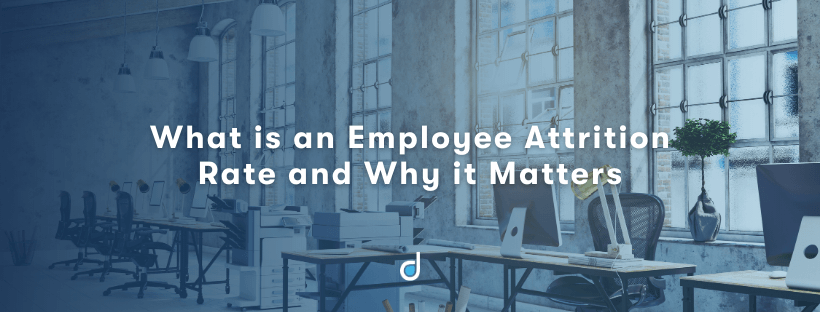Employee retention is crucial to your company’s success and the attrition rate is the metric that provides insight into how well you’re retaining your employees.
Measuring and analysing your company’s attrition rate will allow you to determine how many employees left your company within a certain period and understand why they left. Then, you can develop relevant and effective retention strategies to reduce attrition within your organisation.
With this article we aim at helping you learn what employee attrition is and how it differs from employee turnover. We’ll also see how you can calculate the employee attrition rate, what are the most common attrition causes and how you can prevent it.
What is an Employee Attrition?
Employee attrition is defined as the unpredictable and uncontrollable, but normal, reduction of the workforce due to resignations, retirement, sickness, or death. The employee attrition rate measures the number of people who move out of a company and are not replaced.
Employee Attrition Vs Employee Turnover
Employee attrition is often confused with employee turnover. Although both attrition and turnover occur when an employee leaves the company, there is a key difference. When it comes to turnover, the company makes efforts to replace the lost employee, but in attrition cases, the vacancy remains unfilled, or the employer completely eliminates that position.
Attrition rates help you understand how well you’re retaining your talent. For instance, a high attrition rate indicates that your employees are leaving frequently, while a low rate shows that you’re keeping your employees for longer periods of time.
Usually, employers look to reach a low attrition rate since it means that their employees are satisfied and they don't have to invest in hiring and training new people.
Why Does Employee Attrition Matter?
Having a clear view of your employee attrition rate is essential to help you understand where your company stands in terms of candidate retention. If you find that your employee attrition rate is high, for instance, it can mean that you’re not providing enough benefits or the best work environment to keep your top-performing employees.
By measuring and analysing your attrition rate, you can identify the problems you need to solve to make sure that you keep your employees from leaving you.
How to Calculate Employee Attrition Rate
To calculate your company’s attrition rate, divide the number of employees who have left your company by the average number of employees over a specific period of time (you can calculate this on an annual, monthly or quarterly basis).

Types of Employee Attrition
There are different types of employee attrition and analysing them can help you understand why you’re losing employees and whether you need to take measures to improve engagement. Employee attrition can be:
Voluntary - when an employee chooses to leave the company, the form of attrition is voluntary. Employees may resign for personal reasons, such as taking care of a family member, etc.
Involuntary - when it’s the company that ends employment. This usually happens when companies eliminate positions to reduce staffing costs or determine that the position is no longer needed. This is a common way for companies to control costs.
External - when an employee leaves to go work for another company. Usually it happens when there’s an opportunity to take a position that more closely aligns with the employees’ career path, to get a higher pay or for a shorter commute.
Internal - when employees accept another position within the same company whether to work in another department or receive a promotion.
What Causes High Attrition Rates?
According to the Society for Human Resource Management, every time a business replaces an employee, it can cost the company 6 to 9 months’ salary on average. As such, companies try to keep their attrition rates as low as possible.
To do so, it’s important to understand what’s causing your employees to leave your company. The most common causes of employee attrition are:
Compensation - employees that feel they’re not being paid enough are very likely to leave your company as soon as they get an offer for higher salary. Having an annual pay raise policy can be a good solution to increase retention.
Recognition - according to Gallup, employee recognition is a “low-cost, high-impact activity”, however, very few employers take this into account and most employees don’t feel appreciated at work. This obviously impacts employee morale and retention.
Career progression - the opportunity for growth and development is very important for retaining good employees. Top performing employees that feel stuck in their current job are likely to look for career advancement opportunities in other companies.
Company culture - Providing a positive, people-centric company culture is essential for retaining your best employees. But even before that, it's also very important to hire for cultural fit and bring in the right people.
Stress - employees that often feel overwhelmed by their workload or experience extreme stress situations at work often end up leaving the company.
Want to know more about HR & Recruitment metrics? Check this article.
How Can You Reduce Your Attrition Rates?
Here are a few key steps to take in order to improve your candidate retention and reduce your company's employee attrition rate:
1. Recruit and hire the right people
Hiring the right people for your company helps you increase retention and lower the attrition rates. Using predictive assessments is a great way to determine whether a candidate is the right fit for your company and for the role they’re applying to.
2. Offer competitive compensation & benefits
Being fairly paid is one of the most valued aspects of a job for employees. Make sure you have a competitive compensation policy and don’t forget about offering good benefits. Flexibility is one of the most valued benefits you can offer to your employees. Allow them to determine their own schedule or work from home a few days per week or per month.
3. Promote employee engagement
Employee satisfaction is crucial for retention as well. Make sure to keep your employees engaged. Ask them for feedback about management or the workplace on a regular basis and create a positive environment where they feel valued and heard.
4. Give recognition to employees
Whenever possible let your people know they’re doing well and give them praise for their achievements. Feeling appreciated will make them feel motivated and committed to work.
5. Offer career progression opportunities
Your employees will feel more engaged and confident if they see that their employer is concerned about their growth and provides them with opportunities to reach individual career goals while fulfilling the company's mission. Implementing career paths can also have a direct impact on the entire organisation by improving morale, career satisfaction, motivation, and productivity.

Skeeled offers you the perfect opportunity to bring innovation and digitalisation to your hiring. Check our website or our LinkedIn, Twitter and Facebook pages for further information.
Thanks for reading and see you next time!
Your team here at skeeled




